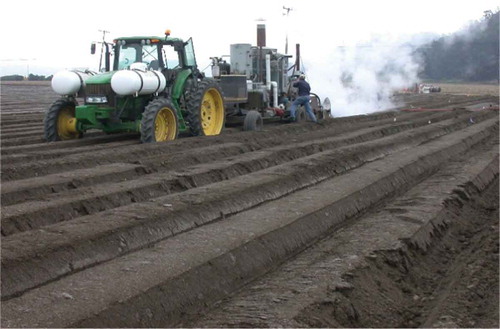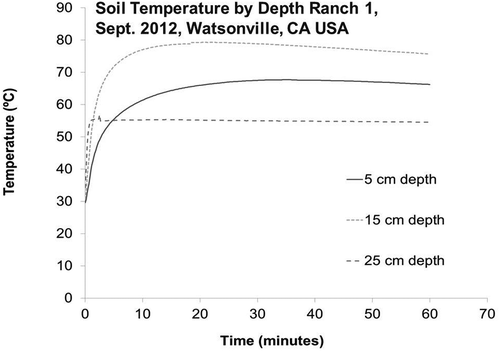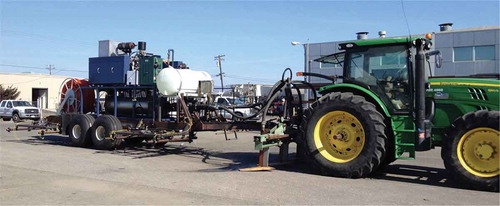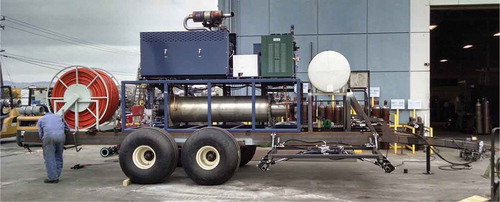ABSTRACT
Increasingly stricter fumigant regulations will limit their use and require effective non-fumigant treatments if large-scale strawberry production is to continue in California. Steam has long been used for soil disinfestation in greenhouse soils where it controls most soil pests. The challenge of field-scale soil disinfestation with steam in place of fumigants is availability of machinery capable of treating a large acreage in a timely manner while making the most efficient use of fuel and water. Steam can be a component within an integrated set of fumigant and non-fumigant practices. Steam used together with other practices may permit technically and economically sustainable strawberry production into the future by allowing growers to adapt to more stringent fumigant use restrictions. It may be possible to overcome some of the limitations of steam because steam generator technology has advanced in recent years as well as recent developments in co-applications with steam, including exothermic compounds co-applied with steam and mustard seed meal co-applied with steam. Regarding steam generator technology, direct-fire steam generators are more energy efficient than traditional steam boilers and avoid the hazards of steam pressure vessels. Steam is arguably the most effective non-fumigant method of soil disinfestation and it likely has a role in a future California strawberry production system that is forced to use much less fumigant than it does at present.
Introduction
Control of soil pests in the United States with steam can be traced back to 1893 in Illinois (Johnson, Citation1946). From the very beginning it was observed that soil steaming controlled soil pathogens and weeds and improved the vigor of plants grown on steamed soil. Steam applied to soils until temperatures reach 65 °C for 20 to 30 min will control most soil pests (Baker and Roistacher, Citation1957). The low cost and high efficacy of fumigants like methyl bromide (MB) displaced much use of steam in horticultural crops during the 1960s (Wilhelm, Citation1966). However, now as the end of MB for critical use in strawberry fruiting fields nears, there is increased interest in steam for control of soil pests (USEPA, Citation2015).
Strawberry in California has traditionally been grown on soils fumigated with MB (Wilhelm and Paulus, Citation1980). Use of MB in California strawberry has been declining steadily since before 2005 and will soon be zero (USEPA, Citation2015). Fumigant alternatives to MB available in California include 1,3-dicloropropene (1,3-D), chloropicrin (Pic), dazomet (DZ), and metam sodium (MS). Strawberry growers would benefit from non-fumigant tools when and where fumigants are unavailable due to local use restrictions, proximity to sensitive sites, lack of resistant strawberry germplasm, and in organic fields where fumigants cannot be used (Fennimore et al., Citation2014). Non-fumigant alternatives available include anaerobic soil disinfestation (ASD), biofumigants such as mustard seed meal (MSM), steam, substrate production (soilless or reduced soil systems), and breeding for disease resistance in strawberry (CADPR, Citation2013).
Much time and effort has been spent developing fumigant alternatives to MB (Fennimore et al., Citation2003, Citation2008; Garcia-Mendez et al., Citation2008; Haar et al., Citation2003; Kabir et al., Citation2005; Klose et al., Citation2007; Lopez-Aranda et al., Citation2009; Samtani et al., Citation2011, Citation2012; Stromberger et al., Citation2005), and the alternatives have allowed growers to reduce their use of MB in California (USDS, Citation2013). Currently registered alternative fumigants, such as 1,3-D, Pic, and combinations, have been tested and are effective at controlling soil pests (Fennimore et al., Citation2003). Fumigant regulations in California, such as the township cap, which places a geographic cap on 1,3-D use, upper limits on Pic dose in sensitive sites, and requirements for buffer zones where fumigant cannot be applied, all limit the potential for these fumigants to completely replace MB (Carpenter et al., Citation2001). Strawberry growers use the alternative fumigants where they can and remaining stocks of MB when possible.
An effective Integrated Pest Management (IPM) program consists of methods to prevent entry of new pests into a field; eradication of troublesome pests; and control consisting of physical, cultural, and chemical methods (Strand, Citation2008). For the past five decades, the chemical control method used most often for soil pests in strawberry has been MB plus Pic. However, in buffer zones and sensitive sites, chemical fumigants either cannot be used, or the upper dose is severely limited, e.g., 140 kg ha–1 Pic in sensitive sites, a dose far below that required for control of Verticillium dahliae (Wilhelm et al., Citation1961) if applied alone. Ineffectively controlled Verticillium propagules can reside in soil and infect new hosts as long as 14 years later (Wilhelm, Citation1955). Here, we propose that steam is a potential method to suppress soil pests prior to strawberry planting in areas that cannot be fumigated with effective rates.
The California strawberry industry
In 2014, 16,801 ha of strawberries were harvested in California, with a total crop value of $2.48 million (NASS-USDA, Citation2015). California Strawberry Commission (CSC) reports indicate that projected strawberry plantings were 15,157 ha for the 2015 season (CSC, Citation2015). Most of this production occurs in the southern and central counties along the California coast where the climate allows strawberries to be harvested year round. While crop rotation is desirable to suppress soil pests in strawberry production fields, the high land rents, e.g., $9366 ha–1 in Oxnard, CA, and limited land available make it economically impractical to implement (Daugovish et al., Citation2011). Strawberry producers have traditionally been among the largest consumers of MB in the country (USDA, Citation2000), which is normally combined with Pic due to synergy (Wilhelm et al., Citation1961). The primary reason for fumigating strawberry fields with MB plus Pic is to manage devastating diseases caused by Verticillium dahliae (Martin and Bull, Citation2002) and Phytophthora spp., as well as the combined effects of several to all of the following: Cylindrocarpon spp., some Fusarium spp., Hainesia lythri, Iridiella lunata, Leptosphaeria coniothyrium, Pyrenochaeta (Phoma) spp., Pythium spp., some Rhizoctonia spp., and Stemphylium spp., especially in the presence of parasitic nematodes in what is known as the black root complex (Berkeley and Lander-Thompson, Citation1934; Strong and Strong, Citation1931; Wilhelm, Citation1952), which can involve additional genera and species in other countries, and since the reduction in use of MB, Macrophomina phaseolina (Koike, Citation2008), and Fusarium oxysporum f. sp. fragariae (Koike et al., Citation2009).
With the phase out of MB, economic analysis suggests that weed control costs in strawberry will rise, and yield losses in the range of 10% to 15% will be observed (Goodhue et al., Citation2005). Alternative fumigants are less effective than MB in controlling weeds, such as yellow nutsedge (Daugovish et al., Citation2007). The concentration of strawberry production in a small number of coastal areas has caused various townships to reach limits, i.e., “township caps,” for the amounts of 1, 3-D available. Township caps will continue to limit the allowed usage of 1, 3-D (Carpenter et al., Citation2001). MB use is rapidly declining due to its internationally regulated availability, and is also subject to township cap limits, which impact use, even if ample supply were available. A viable non-fumigant alternative may allow growers to disinfest and cultivate land that could not otherwise be fumigated.
Pest control through steam
During the process of disinfestation, steam distribution in the soil occurs mainly through conduction (Minuto et al., Citation2003). Studies have shown that most plant pathogens, insects, and weeds are controlled when moist soils are heated to temperatures of 65 °C for 30 min (Baker and Roistacher, Citation1957). The time and amount of steam needed to raise the soil temperature to 65 °C depends on various soil factors, including texture, type, and moisture content. Minuto et al. (Citation2003) found that shorter steam application times corresponded to soil moisture content between 8.5% and 12% in sandy-loam soil and between 6% and 7% in a sandy soil. Miller et al. (Citation2014) found that physically mixing steam with soil was more efficient than applying steam to still soil, and these findings were incorporated into the design of the steam applicator prototype built in 2011 (). This was supported by monitoring of soil temperatures, both in the lab with controlled doses of steam in constant conditions in either a static or mixing steam application, and in the field (Fennimore et al., Citation2014) to validate achievement of effective temperature and duration for thermal kill of weeds and pathogens (). Targeted temperatures of 70 °C for 30 min in a 1.3-m-wide bed were regularly achieved in the field to a depth of 0 to 25 cm (), and future steam applicator designs will allow us to increase operation efficiency and reduce fuel use, while effectively managing soil-borne diseases and other pests. Steam applied to field soil that raised the temperature to 60 °C for 20 min resulted in weed control comparable to MB (Vidotto et al., Citation2009). One advantage of steaming in addition to pest control is that it lacks the negative environmental and worker health issues associated with chemical fumigants. Some have reported that steaming has little to no lasting effect on soil quality or soil microbial communities (Jäderlund et al., Citation1998; Norberg et al., Citation2001; Roux-Michollet et al., Citation2008; Zackrisson et al., Citation1997) as opposed to the potential impacts of MB fumigation (Ibekwe et al., Citation2001; Ros et al., Citation2008; Yamamoto et al., Citation2008). Some studies have reported a more significant change in soil microbial activity due to steam disinfestation (Tanaka et al., Citation2003; Yamamoto et al., Citation2008). Differences may be related to duration of steam application and soil temperatures reached during steam treatments as well as the soil organic matter content. Another advantage for steam pertains to increased crop growth and yields (Luvisi et al., Citation2006; Moyls et al., Citation1994). Six years of field research with steam for soil disinfestation have found no detrimental effects on strawberry yields or soil fertility (Fennimore et al. Citation2014; Samtani et al. Citation2012).
Steam generators and steam applicators
There are two types of steam generators—traditional steam boilers (Baker and Roistacher, Citation1957) and direct-fire steam generators (Hoffmann et al. Citation2015). Steam boilers utilize a pressure vessel containing water that is heated to generate steam, which is injected into the soil under pressure. Direct-fire steam generators utilize a metal jacketed ceramic tube to contain a propane fueled flame that acts as a heat source to instantaneously convert a water stream to steam, i.e., flash steam. Steam generated by this manner is pushed by a hot air steam into the treated soil (Hoffmann et al., Citation2015). A direct fire steam generator from Johnson Gas Appliance (http://www.johnsongas.com/industrial/concrete.asp) has been adapted for heat treatment of soils (Hoffmann et al., Citation2015).
Field steam applicators are a combination of a tractor-towed or self-propelled device, a steam generator, and an injection system that delivers steam to the soil. The two general classifications of field steam applicators are discontinuous and continuous. Discontinuous applicators, like the Ferarri Steriliter (Ferrari Construzioni Meccaniche, Guidizzolo, Italy), utilize a method known as “sandwich steaming,” which combine soil surface and deep injected steam layers (Gay et al., Citation2010). Discontinuous applicators stop to treat an area for 5–7 min then move to the next area in a stepwise progression (http://www.moeschle.de/files/upload/fokie2.pdf). Continuous steam applicators move slowly forward without pause during the steam application. One such commercial steam applicator is the Celli Ecostar (Celli SPA, Forli, Italy), which applies steam to an area 1.6 m wide by 20 cm deep at a speed of up to 150 m h–1 (Gelsomino et al., Citation2010; Peruzzi et al. Citation2011a, Citation2011b). The Celli Ecostar utilizes a rototiller and shank applicator designed to blend steam into the soil in combination with exothermic compounds like KOH or CaO at rates of 1000 to 4000 kg ha–1, which allows for reduced steam input and more even heating of soil to desired ranges of 60 °C to 70 °C and effective kill of soil pests than steam applied alone (Gelsomino et al., Citation2010; Peruzzi et al., Citation2011a, Citation2011b). A prototype continuous steam applicator to treat a 1.3-m-wide bed by 30 cm high was reported by Fennimore et al. (Citation2014). This tractor-towed applicator injected steam applicator powered by a 2638 Mj h–1 Clayton steam generator (Clayton Industries, City of Industry, CA, USA) consistently raised soil temperatures to 60 °C to 70 °C for >20 min, killing soil pests and providing strawberry yields similar to fumigated soils.
We have observed that the combination of steam with mustard seed meal (MSM) incorporation provides results that appear synergistic in nature, offering greater pest control than either treatment alone (Fennimore et al., Citation2014). Though Brassica spp. sources vary, all owe activity in large part to degradation of sinigrin (allyl glucosinolate) to the volatile allyl isothiocyanate (AITC). Early findings support the hypothesis that the higher temperature afforded by steam liberates AITC at more effective doses. Findings thus far suggest that steam + MSM are more effective in combination than either compound alone (Fennimore et al., Citation2014).
Economic viability of steam application
In urban areas like coastal areas of California where most strawberry is grown, growers will increasingly require non-fumigant alternatives to MB and other fumigants. Regulations limit the use of fumigants and reduce the land available to grow crops that require fumigation like strawberry. Township caps limit total 1, 3-D use, and hence reduce land available for fumigation and strawberry production (Carpenter et al., Citation2001). Sensitive sites require buffer zones, which also reduce the land that can be fumigated. The commercial viability of steam is easily assessed in the case of buffer zones by comparison of strawberry grown on steam-treated and nontreated soils.
The effects of sensitive site restrictions for a typical farm in Ventura County, a significant strawberry production region of California’s southern coast, illustrate the commercial viability of steam. The grower manages the farm using 91-m-wide blocks, as is standard for strawberry production. Custom fumigation companies work with two distinct zones: zones that can be fumigated and zones that cannot be fumigated, such as buffer zones due to a church, school, hospital, prison, or some other sensitive site. illustrates these two perspectives. The example farm consists of 29.1 ha that can be cropped, of which 26.3 ha can be fumigated and 2.8 ha cannot be fumigated.
Figure 3. A grower’s view of a 29.1 ha farm on top divided into 91-m-wide blocks as is the normal method for strawberry production (top). Portions of three blocks are close to a neighborhood and another block is within 400 m of a school and thus fumigant applications are limited to a few hours on weekends. In the case of a continuously occupied hospital or jail or a school with weekend activities, then fumigation would not be feasible. On the bottom is the fumigant/steam provider’s view of the same farm. Custom steam application could take place within white buffer zones and fumigants could be used in the remainder of the field.
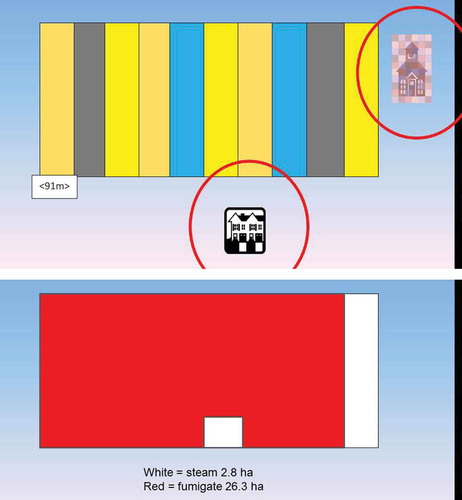
The grower increases total net revenues by planting strawberry on as much of the farm as possible; revenues are higher than with cover crops and it is not practical to grow alternative crops that do not require fumigation at the scale of the buffer zones. As noted earlier, land rents are quite high in the study area and strawberries are one of the few crops that generate sufficient revenues to cover land rent and other expenses. Regarding the question of whether steam treatment increases net returns, we compare net returns from the farm with the 2.8 ha steamed versus no soil disinfestation treatment.
Custom treatment using Pic-Clor 60 fumigant on 26.3 ha at $4693 ha–1 is $123,426; using an estimated fee for steam application of $12,350 ha–1, which for 2.8 ha is $34,580, bringing the total farm disinfestation cost to $158,006. We assume that all other costs are independent of the soil disinfestation treatment (fumigation or steam). All other costs excluding hand weeding costs are assumed to be the same for treated and untreated land. In this region, weeding costs are two to three times as high for organic land as for treated land so we assume a multiple of 2.5, leading to an increase in weeding costs of $1112 ha–1 (Bolda et al., Citation2014). The strawberry price is a volume-weighted average of the fresh and processed strawberry prices used in Daugovish et al. (Citation2011). Yields are for the Albion cultivar and are 60.9 t ha–1 for fumigated and steam treatments and 28.5 t ha–1 (P = 0.05) on untreated land (Fennimore et al., Citation2014).
The farm’s gross revenue is $106,341 ha–1 * 29.1 ha = $3.1 M if the whole farm is cropped and the buffer is treated with steam versus $2.8 M if only the 26.3 ha that can be fumigated are cropped. If the entire farm is cropped and the buffer is left untreated the farm will have gross revenues of $2.9 M.
Utilizing steam on the buffer increases net revenues, not only gross revenues, because the much higher yield leads to an increase in revenue that substantially outweighs the treatment costs. The effect of the higher weeding costs for the untreated buffer is comparatively small. Gross revenues are $158,412 higher for the buffer acreage when steamed, and weeding costs are $2112 lower. Treatment costs are $34,580. Combining these effects, net returns on the buffer increase by $129,745 due to the use of steam.
In reality the benefits of steam versus no steam are much higher for the field as a whole because producing strawberry on non-fumigated soil creates a refuge for pests, such as Macrophomina phaseolina, and weeds that can increase in severity and infest the whole farm, reducing yields and increasing costs. Also, the value of increased harvest efficiency because of more time spent harvesting at one 29.1 ha site versus only 26.3 ha, is not calculated here. There are fixed costs per harvest day, such as transportation for labor and materials, which are reduced on a per-hectare basis when a larger field is harvested.
Two concerns regarding the economic viability of steam applications in commercial production are the length of time required to treat a field and the high cost of fuel. Recent innovations in applicator technology have mitigated those concerns. A steam applicator, such as the one being built for this project, has an application rate of 36.6 h ha–1. It could treat the 2.8 ha in about 4 days, less than the 5-day post-fumigation re-entry interval required before tarp cutting. Fumigating the remainder of the field would take 2 days; provided steam and fumigation treatments can be conducted concurrently, steam would not increase the current total treatment time of 7 days.
Advances in applicator design have reduced fuel costs. The current design on a steam applicator is a 5-mm BTU steam generator, which would consume 7598 L ha–1 propane, which in recent pricing of $0.41 L–1 is $3130 ha–1 fuel cost (). The design is based on a direct-fire steam generator (). In addition to higher fuel efficiency, direct-fire steam generators have other advantages over a conventional steam generator, such as no requirement to be level during the application process and no explosion hazard from a pressure vessel.
Summary
Fumigants are the long-standing preferred version of soil disinfestation in California strawberry fields. However, increasing regulation on the use of fumigants will likely result in increasing area that cannot be fumigated. Thus the options are: (1) not grow strawberry in fields near sensitive sites; (2) continue to utilize fields near sensitive sites but only crop the areas that can be fumigated; and (3) find an effective non-fumigant treatment to use in areas that cannot be fumigated and fumigate the areas that can be fumigated (). Here, we propose one such non-fumigant alternative—soil disinfestation with steam—and evaluate its effects using an example of a specific farm affected by buffer zones around sensitive sites.
Literature cited
- Baker, K.F. and C.N. Roistacher. 1957. The U.C. system for producing healthy container-grown plants. Calif. Agr. Expt. Sta. Ext. Serv. Manual 23.
- Berkeley, G.H. and I. Lander-Thompson. 1934. Root rot of strawberry in Britain. The “Black Lesion” type of strawberry root rot. J. Pomol. Hort. Sci. 12:222–246.
- Bolda, M., L. Tourte, K. Klonsky, R.L. DeMoura, and K. Tumber. 2014. 2014 Sample costs to produce organic strawberries. University of California Davis Agriculture and Resource Economics Cost and Return Studies. http://coststudyfiles.ucdavis.edu/uploads/cs_public/94/4b/944b5aad-6660-4dcd-a449-d26361afcae2/strawberry-cc-organic-2014.pdf. Accessed 2 July 2016.
- CADPR. 2013. Nonfumigant strawberry production working group action plan. http://www.cdpr.ca.gov/docs/pestmgt/strawberry/work_group/action_plan.pdf. Accessed 2 July 2016.
- Carpenter, J., L. Lynch, and T. Trout. 2001. Township limits on 1, 3-D will impact adjustment to methyl bromide phase-out. Calif. Agr. 55(3):12–18.
- CSC. 2015. 2015 Acreage survey update. https://calstrawberry1-web.sharepoint.com/Reports/Acreage%20Survey/2016%20Acreage%20Survey.pdf. Accessed 2 July 2016.
- Daugovish, O., K.M. Klonsky, and R.L. De Moura. 2011. Sample costs to produce strawberries. http://coststudies.ucdavis.edu/current.php
- Daugovish, O., M. Mochizuki, and S. Fennimore. 2007. Control of difficult weeds in strawberry production in non-fumigated areas. Proc. Annu. Intl. Res. Conf. Methyl Bromide Altern. Emissions Reductions. Abstract 53.
- Fennimore, S.A., M.J. Haar, and H.A. Ajwa. 2003. Weed control in strawberry provided by shank and drip applied methyl bromide alternative fumigants. HortScience 38:55–61.
- Fennimore, S.A., M.J. Haar, R.E. Goodhue, and C.Q. Winterbottom. 2008. Weed control in strawberry runner plant nurseries with methyl bromide alternative fumigants. HortScience 43:1495–1500.
- Fennimore, S.A., F.N. Martin, T.C. Miller, J.C. Broome, N. Dorn, and I. Greene. 2014. Evaluation of a mobile steam applicator for soil disinfestation in California strawberry. HortScience 49:1542–1549.
- Garcia-Mendez, E., D. Garcia-Sinovas, M. Becerril, A. De Cal, P. Melgarejo, A. Martinez-Treceno, S.A. Fennimore, C. Soria, J.J. Medina, and J.M. Lopez-Aranda. 2008. Chemical alternatives to methyl bromide for weed control and runner plant production in strawberry nurseries. HortScience 43:177–182.
- Gay, P., P. Piccarolo, D. Ricauda Aimonino, and C. Tortia. 2010. A high efficiency steam soil disinfestation system, Part II: Design and testing. Biosyst. Eng., 107:194–201.
- Gelsomino, A., B. Petrovičová, F. Zaffina, and A. Peruzzi. 2010. Chemical and microbial properties in a greenhouse loamy soil after steam disinfestation alone or combined with CaO addition. Soil Biol. Biochem. 42:1091–1100.
- Goodhue, R.E., S.A. Fennimore, and H.A. Ajwa. 2005. The economic importance of methyl bromide: Does the California strawberry industry qualify for a critical use exemption from the methyl bromide ban? Rev. Agr. Econ. 27:198–211.
- Haar, M.J., S.A. Fennimore, H.A. Ajwa, and C.Q. Winterbottom. 2003. Chloropicrin effect on weed seed viability. Crop Protection 22:109–115.
- Hoffmann, M., T. Miller, J. Rachuy, N. Dorn, I. Greene, J. Broome, R. Goodhue, and S. Fennimore. 2015. Soil disinfestation with steam in California strawberry production. Methyl Bromide Altern. Outreach. Abstract 18.
- Ibekwe, A.M., S.K. Papiernik, J. Gan, S.R. Yates, C.H. Yang, and D.E. Crowley. 2001. Impact of fumigants on soil microbial communities. Appl. Environ. Microbiol. 67:3245–3257.
- Jäderlund, A., G. Norberg, O. Zackrisson, A. Dahlberg, D. Teketay, A. Dolling, and M.C. Nilsson. 1998. Control of bilberry vegetation by steam treatment—Effects on seeded Scots pine and associated mycorrhizal fungi. For. Ecol. Manage. 108:275–285.
- Johnson, J. 1946. Soil steaming for disease control. Soil Sci. 61:83–92.
- Kabir, Z., S.A. Fennimore, J.M. Duniway, F.N. Martin, G.T. Browne, C.Q. Winterbottom, H.A. Ajwa, B.B. Westerdahl, R.E. Goodhue, and M.J. Haar. 2005. Alternatives to methyl bromide for strawberry runner plant production. HortScience 40:1709–1715.
- Klose, S., H.A. Ajwa, S.A. Fennimore, F.N. Martin, G.T. Browne, and K.V. Subbarao. 2007. Dose response of weed seeds and soilborne pathogens to 1,3-D and chloropicrin. Crop Protection 26:535–542.
- Koike, S.T. 2008. Crown rot of strawberry caused by Macrophomina phaseolina in California. Plant Dis. 92:1253.
- Koike, S.T., S.C. Kirkpatrick, and T.R. Gordon. 2009. Fusarium wilt of strawberry caused by Fusarium oxysporum in California. Plant Dis. 93:1077.
- Lopez-Aranda, J.M., L. Miranda, J.J. Medina, C. Soria, B. de los Santos, F. Romero, R.M. Perez-Jimenez, M. Talavera, S.A. Fennimore, and B.M. Santos. 2009. Hort. Technol. 19:187–192.
- Luvisi, A., A. Materazzi, and E. Triolo. 2006. Steam and exothermic reactions as alternative techniques to control soil-borne diseases in basil. Agron. Sustainable Dev. 26:201–207.
- Martin, F.N. and C.T. Bull. 2002. Biological approaches for control of root pathogens of strawberry. Phytopathology 92:1356–1362.
- Miller, T.C., J.B. Samtani, and S.A. Fennimore. 2014. Mixing steam with soil increases heating rate compared to steam applied to still soil. Crop Protection 64:47–50.
- Minuto, G., A. Minuto, M.L. Gullino, and A. Garibaldi. 2003. Il calore umido per la disinfestazione del terreno: Osservazioni sulle condizioni di applicazione [Moist heat for soil disinfestation: observations on the application conditions]. Informatore Fitopatologico 10:66–72.
- Moyls, A.L., R.P. Hocking, G.H. Neilsen, and E.J. Hogue. 1994. Apple tree growth response in greenhouse pot tests using heat-treated replant soil versus orchard replanted trees with in situ heated soil. Acta Hortic. 363:57–63.
- NASS-USDA. 2015. 2014 State Agriculture Overview: California. http://www.nass.usda.gov/Quick_Stats/Ag_Overview/stateOverview.php?state=CALIFORNIA. Accessed 2 July 2016.
- Norberg, G., A. Dolling, A. Jäderlund, M.C. Nilsson, and O. Zackrisson. 2001. Control of heather by steam treatment: Effects on establishment and early growth of Scots pine. New For. 21:187–198.
- Peruzzi, A., M. Raffaelli, C. Frasconi, M. Fontanelli, and P. Bàrberi. 2011b. Influence of an injection system on the effect of activated soil steaming on Brassica juncea and the natural weed seedbank. Weed Res. 52(2):140–152.
- Peruzzi, A., M. Raffaelli, M. Ginanni, M. Fontanelli, and C. Frasconi. 2011a. An innovative self-propelled machine for soil disinfection using steam and chemicals in an exothermic reaction, Biosys. Eng. 110:434–442.
- Ros, M., C. Garcia, M.T. Hernandez, A. Lacasa, P. Fernandez, and J.A. Pascual. 2008. Effects of biosolarization as methyl bromide alternative for Meloidogyne incognita control on quality of soil under pepper. Biol. Fertil. Soils 45:37–44.
- Roux-Michollet, D., S. Czarnes, B. Adam, D. Berry, C. Commeaux, N. Guillaumaud, X. Le Roux, and A. Clays-Josserand. 2008. Effects of steam disinfestation on community structure, abundance and activity of heterotrophic, denitrifying and nitrifying bacteria in an organic farming soil. Soil Biol. Biochem. 40: 1836–1845.
- Samtani, J.B., H.A. Ajwa, J.B. Weber, G.T. Browne, S. Klose, J. Hunzie, and S.A. Fennimore. 2011. Evaluation of non-fumigant alternatives to methyl bromide for weed control and crop yield in California strawberries (Fragaria ananassa L.). Crop Protection 30:45–51.
- Samtani, J.B., C. Gilbert, J.B. Weber, K.V. Subbarao, R.E. Goodhue, and S.A. Fennimore. 2012. Effect of steam and solarization treatments on pest control, strawberry yield, and economic returns relative to methyl bromide fumigation. HortScience 47:64–70.
- Strand, L. 2008. Integrated pest management for strawberries, 2nd ed. Statewide Integrated Pest Management Program, University of California Agricultural and Natural Resources Publication 3351. University of California, Agriculture and Natural Resources, Oakland, CA.
- Stromberger, M.E., S. Klose, H. Ajwa, T. Trout, and S. Fennimore. 2005. Microbial populations and enzyme activities in soils fumigated with methyl bromide alternatives. Soil Sci. Soc. Amer. J. 69: 1987–1999.
- Strong, F.C. and M.C. Strong. 1931. Investigations on the black root of strawberry. Phytopathology 21:1041–1060.
- Tanaka, S., T. Kobayashi, K. Iwasaki, S. Yamane, K. Maeda, and K. Sakurai. 2003. Properties and metabolic diversity of microbial communities in soils treated with steam sterilization compared with methyl bromide and chloropicrin fumigations. Soil Sci. Plant Nutr. 49:603–610.
- USDA. 2000. Economic implications of the methyl bromide phase-out. Information Bull. No. 756. http://www.ers.usda.gov/Publications/AIB756/. Accessed 2 July 2016.
- USDS. 2013. Methyl bromide critical use nomination for preplant soil use for strawberry fruit grown in open fields. ( Submitted in 2012 for the 2014 use season.) http://www.epa.gov/ozone/mbr/2014_nomination.html. Accessed 2 July 2016.
- USEPA. 2015. 2016 critical use exemption nominations from the phaseout of methyl bromide. https://resources.regulations.gov/document?D=EPA-HQ-OAR-2013-0369-0032. Accessed 2 July 2016.
- Vidotto, F., M. Letey, and D. Ricauda-Aimonino. 2009. Effects of soil steaming on weed seed viability. Abstracts. European Weed Res. Soc. 8th EWRS Workshop on Physical and Cultural Weed Control, Zaragoza, Spain, p. 56.
- Wilhelm, S. 1952. Verticillium wilt and black root rot of strawberry. Calif. Agr. 6: 8–9,14.
- Wilhelm, S. 1955. Longevity of the Verticillium wilt fungus in the laboratory and the field. Phytopathology 45:180–181.
- Wilhelm, S. 1966. Chemical treatments and inoculum potential of soil, p. 53–78. In: J.G. Horsefall and K.F. Baker (eds.). Annual review of phytopathology, vol. 4. Annual Reviews, Palo Alto, CA.
- Wilhelm, S., and A.O. Paulus. 1980. How soil fumigation benefits the California strawberry industry. Plant Dis. 64:264–270.
- Wilhelm, S., R. Storkan, and J.E. Sagen. 1961. Verticillium wilt of strawberry controlled by fumigation of soil with chloropicrin and chloropicnn-methyl bromide mixtures. Phytopathology 51:744–748.
- Yamamoto, T., V.U. Ultra Jr., S. Tanaka, K. Sakurai, and K. Iwasaki. 2008. Effects of methyl bromide fumigation, chloropicrin fumigation, and steam sterilization on soil nitrogen dynamics and microbial properties in a pot culture experiment. Soil Sci. Plant Nutr. 54:886–894.
- Zackrisson, O., G. Norberg, A. Dolling, M. Nilsson, and A. Jäderlund. 1997. Site preparation by steam treatment: Effects on forest vegetation control and establishment, nutrition, and growth of seeded Scots pine. Can. J. For. Res. 27:315–322.

